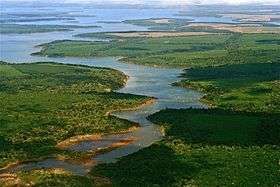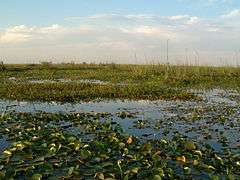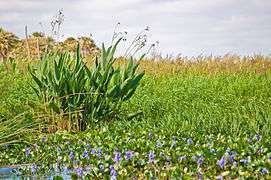Iberá Provincial Reserve
| Iberá Provincial Reserve | |
|---|---|
| Reserva Provincial Iberá | |
|
Low aerial view of Iberá Provincial Reserve | |
 Location within Argentina | |
| Location | Corrientes Province, Argentina |
| Nearest city | Concepción |
| Coordinates | 28°36′0″S 57°48′1″W / 28.60000°S 57.80028°WCoordinates: 28°36′0″S 57°48′1″W / 28.60000°S 57.80028°W |
| Area | 1,300,000 ha (13,000 km2; 5,000 sq mi) |
| Established | April 15, 1983[1] |
| Designated | 2002 |
| Area | 24,500 ha (245 km2; 95 sq mi) |
The Iberá Provincial Reserve (Spanish: Reserva Provincial Iberá, from Guaraní ý berá: "bright water") is a provincial protected area in the north-west of Corrientes Province, north-eastern Argentina. Established on 15 April 1983,[1] it contains a mix of swamps, bogs, stagnant lakes, lagoons, natural sloughs and courses of water. With an area of about 1,300,000 ha (13,000 km2; 5,000 sq mi), the reserve spans a significant 14% of the Corrientes province, and is the largest protected area in the country.
Part of the Iberá Wetlands, a greater system of marshes of 1,500,000–2,000,000 ha (15,000–20,000 km2; 5,800–7,700 sq mi), the second-largest wetland in the world after Pantanal in Brazil, and one of the most important fresh water reservoirs in the continent. In 2002 an area of 24,500 ha (245 km2; 95 sq mi) has been listed as a Wetland of International Importance under the Ramsar convention.[2]
There is an ongoing project to promote the Iberá reserve to national park status.
Description
Throughout the area several permanent lagoons of different size can be distinguished; the largest of them are the eponymous Iberá and Luna, on which banks the village of Colonia Carlos Pellegrini was founded.[upper-alpha 1] The lagoons Fernández, Galarza, Medina, Paraná and Trin also exceed 15 km2 (5.8 sq mi). This lagoon system is typically very shallow, although in times of floods it can reach over three meters deep. Few areas of dry land alternate with these water bodies, mostly low and sandy hills; the rest is covered by a large expanse of floodplains.
Spatial orientation becomes extremely difficult because the exact profile of the solid surface is constantly changing, and the visual continuity between the dry land and swamps is almost seamless due to the large number of semi-submerged vegetation. In addition, natural dams are formed by root entanglement of floating vegetation formations that are sometimes strong enough to walk on them.
The climate is distinctly subtropical. Winters are relatively dry, with minimum temperatures reaching −5 °C (23 °F), and strong precipitations during autumn and spring. Summer is very hot and humid, with highs easily exceeding 45 °C (113 °F). Annual rainfall averages 1,700 mm (67 in).
|
Biodiversity
The natural reserve is known for its biodiversity, including four species that have been declared "provincial natural monuments": the neotropical otter (Lontra longicaudis), the maned wolf (Chrysocyon brachyurus), the pampas deer (Ozotoceros bezoarticus) and the marsh deer (Blastocerus dichotomus). It is also home to the two Argentine species of alligator, the yacare caiman (Yacaré negro) and the broad-snouted caiman (Yacaré overo), as well as the capybara (Hydrochoerus hydrochaeris) (the world's largest rodent), and about 350 bird species.
After almost two-hundred years absence from Argentina, the red-and-green macaw (Ara chloropterus) is the subject of a re-introduction programme. The species is listed as critically endangered in Argentina, although there are no recent records, and it is considered to be extinct in the country. It is listed as a ″a species of global least concern″ on the IUCN Red List. The first birds were released in 2015 by Aves Argentinas, a partner of BirdLife International.[3]
See also
Notes
- ↑ This small town is usually regarded as the most convenient starting point to visit the reserve.
References
- 1 2 Ley No. 3771 de la Provincia de Corrientes; prom.: 15 de abril de 1983
- ↑ "Ramsar Database". Retrieved 28 September 2009.
- ↑ "BirdLife Macaws return to Argentina". BirdGuides. Retrieved 12 November 2015.
External links
| Wikimedia Commons has media related to Reserva Provincial de Iberá. |
- Proyecto Parque Nacional Iberá (Spanish)


.jpg)
.jpg)
.jpg)
